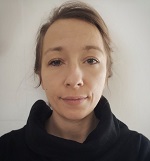ESTRO 2023 Young Track Report
A tough nut to crack ‑ paediatric radiotherapy
Guten tag alles!
It was great to be able to see all of you again, finally in person, at ESTRO 2023 in Vienna, after so many online meetings. Even the rain was unable to dampen the joy regarding the meeting. As always, there were many interesting talks, but not enough time. It's great that many of them were recorded!
I followed the lectures on paediatric radiotherapy with great interest. Aicha Traore-Diallo from France presented the dosimetric comparison of brachytherapy and external beam radiotherapy techniques (protons and photons) for children's rhabdomyosarcoma on Sunday during the proffered papers session – breast, gastrointestinal tract and paediatrics. Three disease sites were compared, and brachytherapy provided the best treatment plans in terms of excellent tumour coverage (with the possibility of dose escalation), low dose to the nearby organs and a steep gradient of the dose outside the treated volume. This could yield significant benefits in terms of improved local control outcomes and reduced rates of toxicity. Several hospitals in Europe offer brachytherapy to treat children, and many are located in France.
The advantages of utilising diverse techniques, such as protons, brachytherapy, and stereotactic radiotherapy, were presented during the teaching lecture held on Tuesday. This was titled Paediatric radiotherapy – what is the state of the art? and was given by Stephanie Bolle, also from France. She demonstrated that the use of proton therapy in children could be particularly challenging when it came to large volumes or small tumours. Even so, many children with brain tumours, especially those who require craniospinal irradiation, could benefit from proton therapy. It was commented that the rate of brainstem necrosis was higher in proton studies, but that incidence rate was also connected to the systemic treatment and lower age of the patient.
The other presentation at this session, MR-guided radiotherapy in paediatric patients by Geert Janssens, showed that we still have a lot of work to do in photon radiotherapy, especially since proton therapy is not on offer for the vast majority of children. MR-guided radiotherapy approachcould be an excellent option for the treatment of moveable tumours; however, only a few children have been treated through the use of these techniques. Until now, neuroblastomas, nephroblastoma, and other cases that involve the abdomen have been investigated, with comparable outcomes in terms of local control to standard IGRT techniques.
It was nice to see Dominik Wawrzuta, a young radiation oncologist from Poland, who discussed the data about reirradiation of diffuse intrinsic pontine glioma in children and gave a clinical and radiomic analysis. The second course of radiotherapy was safe and helped with the management of symptoms. Good work!
See you at the next meeting.

Aleksandra Napieralska
Radiation oncologist
Maria Sklodowska-Curie National Research Institute of Oncology, Gliwice Branch
Gliwice, Poland